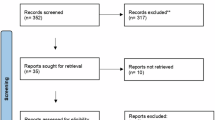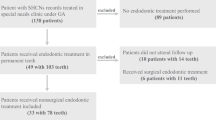Key Points
-
Apex locators are valid tools for use in root length determination in general dental practice.
-
The use of apex locators may help reduce ionisation radiation exposure for patients undergoing root canal treatment.
-
This study highlights the importance of randomised controlled trials in primary dental care settings.
Abstract
Objective To evaluate the ability of apex locators as a tool in determining working length in comparison to traditional working length radiographs in general dental practice.
Design Randomised controlled clinical trial.
Setting General dental practices in the North West of England.
Subjects Adults requiring root canal treatment of at least one tooth with minimal or moderate difficulty.
Intervention Root canal treatment was carried out with the working length determined by apex locator in the treatment group (AL), and periapical radiograph in the control group (PA).
Outcome measure The acceptability of the master cone gutta percha measured from a radiograph before obturation was used as the primary outcome.
Results Twenty-one of 23 fillings in the AL group were judged as acceptable, compared to 17 of 23 fillings in the PA group. This difference was not statistically significant.
Conclusion In general dental practice, no significant difference was found in working length determined using apex locator combined with a master cone GP radiograph or using the conventional method. There is a need for larger trials to investigate these methods further.
Similar content being viewed by others
Log in or create a free account to read this content
Gain free access to this article, as well as selected content from this journal and more on nature.com
or
References
Sjogren U, Hagglund B, Sundqvist G, Wing K . Factors affecting the long-term results of endodontic treatment. J Endod 1990; 16: 498–504.
Farzaneh M, Abitbol S, Lawrence H P, Friedman S . Treatment outcome in endodontics – the Toronto Study. Phase II: initial treatment. J Endod 2004; 30: 302–309.
Schaeffer M A, White R R, Walton R E . Determining the optimal obturation length: a meta-analysis of literature. J Endod 2005; 31: 271–274.
Kuttler Y . Microscopic investigation of root apexes. J Am Dent Assoc 1955; 50: 544–552.
Dummer P M, McGinn J H, Rees D G . The position and topography of the apical canal constriction and apical foramen. Int Endod J 1984; 17: 192–198.
Simon S, Machtou P, Adams N, Tomson P, Lumley P . Apical limit and working length in endodontics. Dent Update 2006; 36: 146–153.
Olson A K, Goerig A C, Cavataio R E, Luciano J . The ability of the radiograph to determine the location of the apical foramen. Int Endod J 1991; 24: 28–35.
Tamse A, Kaffe I, Fishel D . Zygomatic arch interference with correct radiographic diagnosis in maxillary molar endodontics. Oral Surg Oral Med Oral Pathol 1980; 50: 563–566.
Sunada I . New method for measuring the length of the root canal. J Dent Res 1962; 41: 375–387.
Gordon M P, Chandler N P . Electronic apex locators. Int Endod J 2004; 37: 425–437.
Kim E, Lee S J . Electronic apex locator. Dent Clin N Am 2004; 48: 35–54.
ElAyouti A, Dima E, Ohmer J, Sperl K, Von Ohle C, Löst C . Consistency of apex locator function: a clinical study. J Endod 2009; 35: 179–181.
Pagavino G, Pace R, Baccetti T . A SEM study of in vivo accuracy of the Root ZX electronic apex locator. J Endod 1998; 24: 438–441.
Hoer D, Attin T . The accuracy of electronic working length determination. Int Endod J 2004; 37: 125–131.
Tselnik M, Baumgartner J C, Marshall J G . An evaluation of Root ZX and Elements diagnostic apex locators. J Endod 2005; 31: 507–509.
Haffner C, Folwaczny M, Galler K, Hickel R . Accuracy of electronic apex locators in comparison to actual length – an in vivo study. J Dent 2005; 33: 619–625.
Goldberg F, Marroquin B B, Frajlich S, Dreyer C . In vitro evaluation of the ability of three apex locators to determine the working length during retreatment. J Endod 2005; 31: 676–678.
Dental Practice Board. DPB digest of statistics. Eastbourne, UK: Dental Practice Board, 2004.
Molyneux L, Mccullough C, Preston A J, Jarad F D . Apex locator use by general dental practitioners in Merseyside. J Dent Res 2008; 87(Spec Iss C): Abstract number 0166 (PEF IADR). Available from: http://iadr.confex.com/iadr/pef08/techprogram/abstract_111422.htm.
Faculty of General Dental Practice (UK) of the Royal College of Surgeon of England. Selection criteria for dental radiography. London: FGDP(UK), 2004.
European Society of Endodontology. Quality guidelines for endodontic treatment: consensus report of the European Society of Endodontology. Int Endod J 2006; 39: 921–930.
Saad A Y, al-Nazhan S. Radiation dose reduction during endodontic therapy: a new technique combining an apex locator (Root ZX) and a digital imaging system (RadioVisioGraphy). J Endod 2000; 26: 144–147.
Brunton P A, Abdeen D, MacFarlane T V . The effect of an apex locator on exposure to radiation during endodontic therapy. J Endod 2002; 28: 524–526.
American Association of Endodontists. AAE endodontic case difficulty assessment form and guidelines. Endodontics: Colleagues for Excellence 2005; Spring/Summer: 6–7. Available from: http://www.aae.org/uploadedFiles/Publications_and_Research/Endodontics_Colleagues_for_Excellence_Newsletter/ss05ecfe.pdf.
Williams C B, Joyce A P, Roberts S . A comparison between in vivo radiographic working length determination and measurement after extraction. J Endod 2006; 32: 624–627.
Ng Y L, Mann V, Rahbaran S, Lewsey J, Gulabivala K . Outcome of primary root canal treatment: systematic review of the literature – part 2. Influence of clinical factors. Int J Endod 2008; 41: 6–31.
Smadi L . Comparison between two methods of working length determination and its effect on radiographic extent of root canal filling; a clinical study. BMC Oral Health 2006; 6: 4.
Kim E, Marmo M, Lee C-Y, Oh N-S, Kim I-K. An in vivo comparison of working length determination by only Root-ZX apex locator versus combining Root-ZX apex locator with radiographs using a new impression technique. Oral Surg Oral Med Oral Pathol Oral Radiol Endod 2008; 105: e79–e83.
D'Assunção F L, Albuquerque D S, Salazar-Silva J R, Dos Santos V C, Sousa J C . Ex vivo evaluation of the accuracy and coefficient of repeatability of three electronic apex locators using a simple mounting model: a preliminary report. Int Endod J 2010; 43: 269–274.
Wrbas K T, Ziegler A A, Altenburger M J, Schirrmeister J F . In vivo comparison of working length determination with two electronic apex locators. Int Endod J 2006; 40: 133–138.
Stoll R, Urban-Klein B, Roggendorf M J, Jablonski-Momeni A, Strauch K, Frankenberger R . Effectiveness of four electronic apex locators to determine distance from the apical foramen. Int Endod J 2010; 43: 808–817.
Patel S, Kanagasingam S, Mannocci F . Cone beam computed tomography (CBCT) in endodontics. Dent Update 2010; 37: 373–379.
Acknowledgements
This study was funded by the NHS Research and Development Fund, Royal Liverpool and Broadgreen University Hospitals Trust, England. The authors acknowledge the contribution of Mr Ashley Jones in carrying out the randomisation procedure.
Author information
Authors and Affiliations
Corresponding author
Additional information
Refereed paper
Rights and permissions
About this article
Cite this article
Jarad, F., Albadri, S., Gamble, C. et al. Working length determination in general dental practice: a randomised controlled trial. Br Dent J 211, 595–598 (2011). https://doi.org/10.1038/sj.bdj.2011.1052
Accepted:
Published:
Issue date:
DOI: https://doi.org/10.1038/sj.bdj.2011.1052



